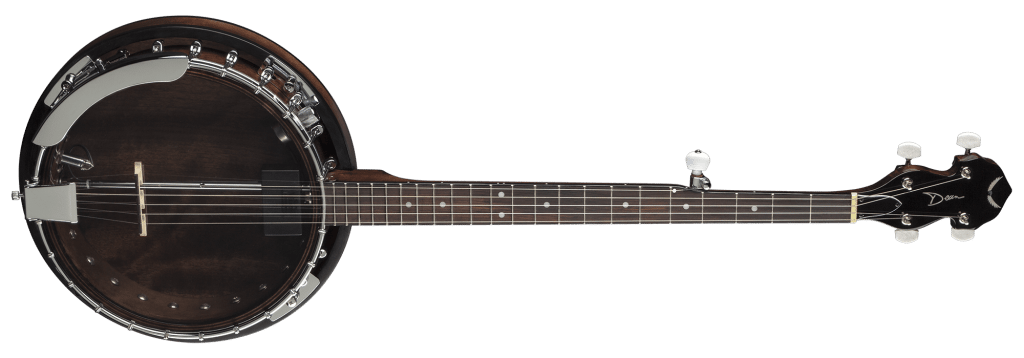
It’s a small mahogany 30’’ scale bass with a neck design that’s faster and more comfortable than Dean’s classic Edge-like design. More so, it has a dual DMT humbucker setup, which gives you plenty of noise-free output for modern rock genres. Active EMG pickups include the usual pairing of a model 81 in the bridge slot and a model 85 in the neck position, each with its own volume and tone controls. Performance The Stealth’s amalgamation of mahogany, maple, ebony and active EMGs is a common configuration in the world of metal guitars, but this Dean’s base tone strikes a lower.
Michael Amott knows a thing or two about tone. Whether it’s vintage death metal with Carcass, hard rock with Spiritual Beggars or his main job in Arch Enemy, Amott has the ears, hands and sense of sonic taste to craft the perfect sound for whatever musical situation he finds himself in. After flings with guitars like the Ibanez RG550 and his former ESP signature model the Ninja, Amott is now a Dean endorser, with his own line of signature guitars. And central to the tone of this imposing axe is the DMT Tyrant, Amott’s signature humbucker from Dean’s pickup division, Dean Magnetic Technologies. Amott was kind enough to arrange for a Tyrant humbucker to be sent out for review after I interviewed him recently.
DEAN Equalizer F-spaced BRIDGE PICKUP electric GUITAR Black/Cream DMT - USA MADE. Dean Vendetta Bridge Pickup. Make Offer - Dean Evo Humbucker Pickup Set. Dean Trivium Matt Heafy White F-Spaced Bridge Pickup. The TIME CAPSULE series of pickups is what Dean currently uses in their original TC series guitars. These pickups capture the biting tones of the vintage Dean instuments produced from 1977 to 1986 with very strong lows and mids. What to expect: Hot output. Thick mids. Flat lows. Great in bridge & neck.
On first glance the Tyrant looks a lot like a Seymour Duncan Invader due to those large nickel hex pole pieces. It doesn’t spec out the same though: the Invader draws its power from three ceramic magnets, overwound coils and twelve black oxide cap screws and it has a DC resistance of 16.8, while the Tyrant uses an Alnico V magnet and has a DC resistance of 16.2K. The Tyrant is also different to the Seymour Duncan JB, the humbucker used in his old ESP signature, which has a DC resistance of 16.8K, although the JB also uses an Alnico V magnet. But there’s a lot more that goes into a pickup’s sound than just magnet type and DC resistance.
I installed the Tyrant into my 1987 Ibanez RG550 for testing. Amott describes the Tyrant’s tone as being similar to his previous pickup but with higher output and a scoop in the mids. That’s certainly a good starting point to describe the sound, but it has enough personality to stand on its own two lugs (gettit?) too. The Tyrant seems to be two different pickups in one: a high-gain one and a more traditionally-voiced one. Crank it up via a heavily saturated metal rhythm tone and it has enough of an upper midrange push to force itself to be heard above the fuzz of distortion, and a tight enough low end to not smear all your ‘chugga chugga’ low-string riffs. The midrange dip doesn’t remove too much thickness from the body of the note, instead subtly thinning it out, giving the impression of a little ‘air’ around the notes. There are some rather blazing harmonic overtones jumping out when you kick into lead mode too, and it tracks very well for fast playing.
Humbucker Pickups Comparison

Use more of a traditional metal amp setting and the Tyrant seems like a different pickup entirely. The natural compression it exhibits in high-gain mode is lifted and it instead becomes quite a dynamic pickup. The mids seem more apparent and the highs seem a little drier – and this is all with all other amp settings unchanged aside from the gain on my Marshall DSL50. It’s here that you really begin to hear how the Tyrant fits in with the Spiritual Beggars side of Amott’s musical personality. It’s kind of like a modern take on the classic NWOBHM-style rhythm tone.
The clean sounds are good too but you probably won’t use them too much if you’re interested in a pickup that looks as mean as this! With this much output it’s hard to get a completely clean sound out of the Tyrant unless you do some serious amp tweaking. But there’s a lot to like if you’re into slightly grittier, grainier clean tone, or if you use an ultra-clean solid state amp like the Roland JC120 which would really keep the Tyrant on a leash.
“It works very nicely for me,” Amott said of the DMT Tyrant. “It’s what’s on the last couple of Arch Enemy albums. That’s what you hear on Khaos Legions: that guitar, that pickup, everything, which is very cool. I’m very happy that I can use my signature equipment in the studio! [Laughs] It’s good stuff. When you’re in the studio, usually the engineer will tell you, “I know you want to use this guitar, but let’s try another one. Okay, I like this one a lot more, play this,” and you end up playing a guitar that you don’t really like playing that much but that sounds better. And that didn’t happen this time around so I’m very, very pleased with that. No problem taking pictures and video in the studio! [Laughs] I can actually represent Dean guitars, so that’s nice. And I can really fly on that guitar. It’s the guitar that I’m most comfortable playing, so it’s just nice that I can play that on the album.”
The Tyrant isn’t just a JB in different clothing or anything like that: if you want a JB, get a JB. What the Tyrant offers in comparison is something a little more specifically dialled in for metal styles, and something which will get Amott fans a little closer to the monster tones on Khaos Legions.
Michael Amott knows a thing or two about tone. Whether it’s vintage death metal with Carcass, hard rock with Spiritual Beggars or his main job in Arch Enemy, Amott has the ears, hands and sense of sonic taste to craft the perfect sound for whatever musical situation he finds himself in. After flings with guitars like the Ibanez RG550 and his former ESP signature model the Ninja, Amott is now a Dean endorser, with his own line of signature guitars. And central to the tone of this imposing axe is the DMT Tyrant, Amott’s signature humbucker from Dean’s pickup division, Dean Magnetic Technologies. Amott was kind enough to arrange for a Tyrant humbucker to be sent out for review after I interviewed him recently.
Humbucker Pickup Sets
On first glance the Tyrant looks a lot like a Seymour Duncan Invader due to those large nickel hex pole pieces. It doesn’t spec out the same though: the Invader draws its power from three ceramic magnets, overwound coils and twelve black oxide cap screws and it has a DC resistance of 16.8, while the Tyrant uses an Alnico V magnet and has a DC resistance of 16.2K. The Tyrant is also different to the Seymour Duncan JB, the humbucker used in his old ESP signature, which has a DC resistance of 16.8K, although the JB also uses an Alnico V magnet. But there’s a lot more that goes into a pickup’s sound than just magnet type and DC resistance.
I installed the Tyrant into my 1987 Ibanez RG550 for testing. Amott describes the Tyrant’s tone as being similar to his previous pickup but with higher output and a scoop in the mids. That’s certainly a good starting point to describe the sound, but it has enough personality to stand on its own two lugs (gettit?) too. The Tyrant seems to be two different pickups in one: a high-gain one and a more traditionally-voiced one. Crank it up via a heavily saturated metal rhythm tone and it has enough of an upper midrange push to force itself to be heard above the fuzz of distortion, and a tight enough low end to not smear all your ‘chugga chugga’ low-string riffs. The midrange dip doesn’t remove too much thickness from the body of the note, instead subtly thinning it out, giving the impression of a little ‘air’ around the notes. There are some rather blazing harmonic overtones jumping out when you kick into lead mode too, and it tracks very well for fast playing.

Dmt Design Humbucker Pickups
Use more of a traditional metal amp setting and the Tyrant seems like a different pickup entirely. The natural compression it exhibits in high-gain mode is lifted and it instead becomes quite a dynamic pickup. The mids seem more apparent and the highs seem a little drier – and this is all with all other amp settings unchanged aside from the gain on my Marshall DSL50. It’s here that you really begin to hear how the Tyrant fits in with the Spiritual Beggars side of Amott’s musical personality. It’s kind of like a modern take on the classic NWOBHM-style rhythm tone.
The clean sounds are good too but you probably won’t use them too much if you’re interested in a pickup that looks as mean as this! With this much output it’s hard to get a completely clean sound out of the Tyrant unless you do some serious amp tweaking. But there’s a lot to like if you’re into slightly grittier, grainier clean tone, or if you use an ultra-clean solid state amp like the Roland JC120 which would really keep the Tyrant on a leash.
“It works very nicely for me,” Amott said of the DMT Tyrant. “It’s what’s on the last couple of Arch Enemy albums. That’s what you hear on Khaos Legions: that guitar, that pickup, everything, which is very cool. I’m very happy that I can use my signature equipment in the studio! [Laughs] It’s good stuff. When you’re in the studio, usually the engineer will tell you, “I know you want to use this guitar, but let’s try another one. Okay, I like this one a lot more, play this,” and you end up playing a guitar that you don’t really like playing that much but that sounds better. And that didn’t happen this time around so I’m very, very pleased with that. No problem taking pictures and video in the studio! [Laughs] I can actually represent Dean guitars, so that’s nice. And I can really fly on that guitar. It’s the guitar that I’m most comfortable playing, so it’s just nice that I can play that on the album.”
The Tyrant isn’t just a JB in different clothing or anything like that: if you want a JB, get a JB. What the Tyrant offers in comparison is something a little more specifically dialled in for metal styles, and something which will get Amott fans a little closer to the monster tones on Khaos Legions.